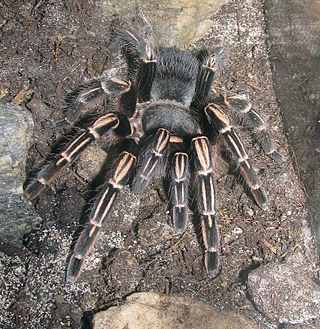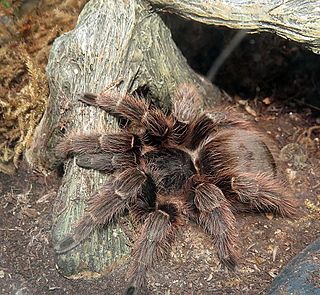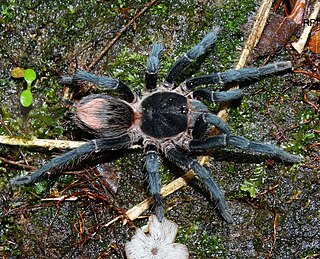
Avicularia is a genus of the family Theraphosidae containing various species of arboreal tarantulas. The genus is native to Panama, the Caribbean and tropical South America. Each species in the genus has very distinguishable pink foot pads.

Aphonopelma is a genus of tarantulas native to the Americas. It includes nearly all the North American tarantula species north of Mexico and a considerable percentage of the tarantula species that range into Central America. Most are fairly large tarantulas with leg spans of 6 in (16 cm) or more. Like most New World tarantulas, all species of Aphonopelma have urticating hairs. Despite their fearsome appearance, these tarantulas are not harmful to humans and some species are popular in the pet trade. With about 90 species described so far, Aphonopelma comprises about 10% of the total number of described tarantula species. However, their taxonomy is poorly understood and species are difficult to tell apart, especially those that are brown or black without other pattern. Therefore, the actual number of species is unknown, with more species likely to be identified in the near future. In captivity, they are usually fed crickets; in the wild, they eat most insects, including crickets, grasshoppers, cockroaches, mantises, and beetles.

Zaruma, officially Villa Real de San Antonio del Cerro de Oro de Zaruma is a town in the south of Ecuador, El Oro Province. It is located in the south-east of this province, at an altitude of 1200 metres above sea level, on an inter-Andes route where the Vizcaya mountain range branches off from the Chilla mountain range. It is the seat of Zaruma Canton, one of the oldest cantons in the province.

Tarantulas comprise a group of large and often hairy spiders of the family Theraphosidae. As of December 2023, 1,100 species have been identified, with 166 genera. The term "tarantula" is usually used to describe members of the family Theraphosidae, although many other members of the same infraorder (Mygalomorphae) are commonly referred to as "tarantulas" or "false tarantulas". Some of the more common species have become popular in the exotic pet trade. Many New World species kept as pets have setae known as urticating hairs that can cause irritation to the skin, and in extreme cases, cause damage to the eyes.
Cyclosternum is a genus of tarantulas that was first described by Anton Ausserer in 1871.

Brachistosternus is a scorpion genus in the Bothriuridae family. B. ehrenbergii is the most cited species in the genus. The genus is distributed in Argentina, Bolivia, Brazil, Chile, Colombia, Ecuador, Paraguay, and Peru.

Acanthoscurria is a genus of tarantulas that was first described by Anton Ausserer in 1871. They are found throughout South America including the countries of Argentina, Bolivia, Brazil, Ecuador, French Guiana, Guyana, Paraguay, Peru, Suriname and Venezuela, plus into the Windward Islands West Indies,.

Ctenus is a genus of wandering spiders first described by Charles Athanase Walckenaer in 1805. It is widely distributed, from South America through Africa to East Asia. Little is known about the toxic potential of the genus Ctenus; however, Ctenus medius has been shown to share some toxic properties with Phoneutria nigriventer, such as proteolytic, hyaluronidase and phospholipase activities, in addition to producing hyperalgesia and edema. The venom of C. medius also interferes with the complement system in concentrations in which the venom of P. nigriventer is inactive, indicating that some species in the genus may have a medically significant venom. The venom of C. medius interferes with the complement component 3 (C3) of the complement system; it affects the central factor of the cascades of the complement, and interferes with the lytic activity of this system, which causes stronger activation and consumption of the complement components. Unlike C. medius, the venom of P. nigriventer does not interfere with lytic activity.

Eupalaestrus is a genus of South American tarantulas that was first described by Reginald Innes Pocock in 1901.

Hermelinda Urvina Mayorga was an Ecuadorian pilot. She was the first Ecuadorian woman to obtain a pilot's license, issued in the United States in 1932.

Hapalopus is a genus of tarantulas that was first described by Anton Ausserer in 1875.

Homoeomma is a genus of South American tarantulas that was first described by Anton Ausserer in 1871. It is considered a senior synonym of Calopelma, Butantania, and of Cyclothoracoides. These tarantulas are usually quite small and usually burrow a few centimeters under a rock or log.

Vitalius is a genus of South American tarantulas that was first described by S. Lucas, P. I. da Silva Jr. & Rogério Bertani in 1993.
Acanthoscurria simoensi is a species of tarantula spider found in Guyana, French Guiana, and Brazil, first described from French Guiana in 2000. The species has been traded in the exotic pet hobby as "Para Mongo Zebra” under spurious scientific names such as 'fracta'. The common name partly relates to the colouration where the females of the species have dark bodies with light coloured linear markings on legs. Notably, like in many other tarantulas with strong sexual dimorpsim, adult males of the species have a different general appearance with a more rusty metallic colouration and comparatively weak linear markings on the legs.












